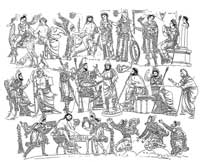.
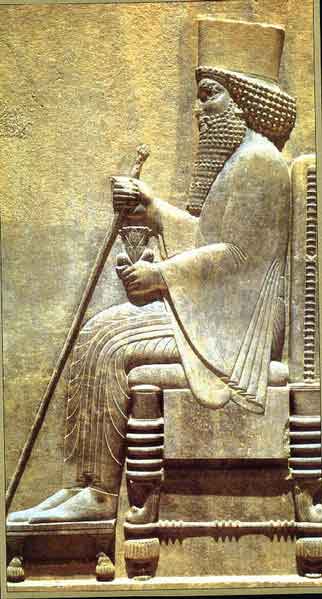
I. I am Darius, the great king, the king of kings, the king of
Persia, the king of the provinces, the son of Hystaspes,
the grandson of Arsames, the Achaemenian.
II. (Thus) saith Darius, the king : My father is Hystaspes ; the
father of Hystaspes was Arsames; the father of Arsames
was Ariyaramnes; the father of Ariyaramnes; was [Teispes] ;
the father of Teispes was Achaemenes.
III. (Thus) saith Darius, the king : On that account are we called
Achaemenians ; from antiquity are we descended ; from
antiquity hath our race been kings
before (me) ; I am the ninth. In two lines have we
been kings.
V. (Thus) saith Darius, the king : By the grace of Auramazda
am I king ; Auramazda hath granted me the kingdom.
VI. (Thus) saith Darius, the king : These are the provinces
which are subject unto me, and by the grace of Auramazda
became I king of them : Persia, Susiana, Babylonia,
Assyria, Arabia, Egypt, the (Islands) of the Sea, Sparda,
Ionia, [Media], Armenia, Cappadocia, Parthia, Drangiana,
Aria, Chorasmia, Bactria, Sogdiana, Gandara, Scythia,
Sattagydia, Arachosia and Maka ; twenty-three lands
in all.
Darius the Great (Old Persian :Dārayawuš - "He Who Holds Firm the Good"), was the son of Hystaspes and Persian Emperor from 521 to 485 BC. His name in Modern Persian is داریوش (Dâriûsh), and the ancient Greek sources call him Δάρειος (Dareios).
Sources for Darius' biography
The principal sources for the life of Darius are his own inscriptions, especially the great inscription of Behistun, in which he relates how he gained the crown and put down many rebellions. In modern times his veracity has often been doubted, but without any sufficient reason or suggestion of alternatives. The accounts given later by Herodotus and Ctesias of his accession are in many points evidently dependent on this official version, with many legendary stories interwoven, e.g. the tale that Darius and his allies left the question as to which of them should become king to the decision of their horses, and that Darius won the crown by a trick of his groom.
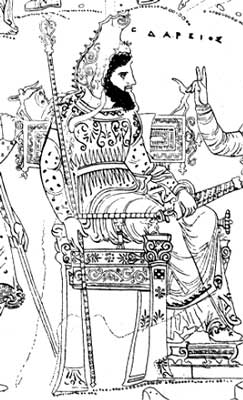
Darius I scence from the Darius Vase
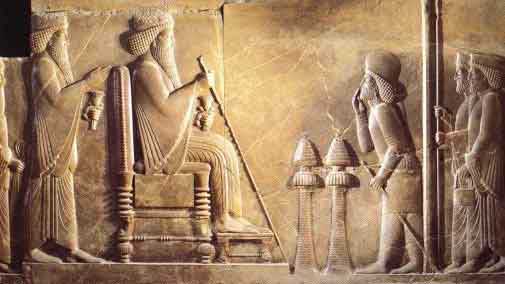
Darius I of Persia, behind him his son Xerxes I, proskynesis
Rise to power
Darius belonged to a cadet branch of the Achaemeid dynasty. When, after the suicide of Cambyses II (March 521), the usurper Gaumata ruled undisturbed over the whole empire under the name of Bardiya (Smerdis), son of Cyrus, no one dared to gainsay him. None, that is, except Darius. Darius "with the help of Ahuramazda", attempted to regain the kingdom for the royal family. His father Hystaspes was still alive, but evidently had not the courage to urge his claims. Actually, according to his incription found at Susa, both Darius's father Hystaspes and his grandfather Arsames, were alive when he became the king. Assisted by six noble Persians, whose names he proclaims at the end of the Behistun inscription, he surprised and killed the usurper in a Median fortress (October 521), and gained the crown. He also married Atossa, the widow of the false Smerdis and daughter of King Cyrus the Great. In time, Xerxes, Darius's son by Atossa, would succeed his father on the throne.
This sudden change in the central authority was perceived by the rulers of the eastern provinces as an opportunity to regain their independence. In Susiana, Babylon, Media, Sagartia, and Margiana, usurpers arose, pretending to be of the old royal race, and gathered large armies around them; in Persia itself Vahyazdata imitated the example of Gaumata and was acknowledged by the majority of the people as the true Bardiya. Darius, with only a small army of Persians and Medes and some trustworthy generals, overcame all these difficulties. By 520/519 all the rebellions were put down. Even Babylon —which had rebelled twice—and Susiana, which had risen three times, both submitted, and the authority of Darius was established throughout the empire.

Lancer, detail from the archers' frieze in Darius' palace, Susa. Silicious glazed bricks, c. 510 BC.
Louvre, (Sb 3320) Paris [Source]
The empire under Darius
Governance
Darius in his inscriptions appears as a fervent believer in the monotheistic religion of Zoroaster. He was also a great statesman and organizer. The time of conquests had come to an end; the wars which Darius undertook, like those of Augustus, only served the purpose of gaining strong natural frontiers for the empire and keeping down the barbarous tribes on its borders. Thus Darius subjugated the wild nations of the Pontic and Armenian mountains, and extended the Persian dominion to the Caucasus; for the same reasons he fought against the Saka and other Iranian steppe tribes, as well as the mysterious Turanians from beyond the Oxus. But by the organization which he gave to the empire he became the true successor of the great Cyrus. His organization of the provinces and the fixing of the tributes is described by Herodotus (iii. 90 if.), evidently from good official sources. He divided the Persian Empire into twenty provinces, each under the supervision of a governor or satrap. The satrap position was usually hereditary and largely autonomous, allowing each province its own distinct laws, traditions, and elite class. Every region, however, was responsible for paying a gold or silver tribute to the emperor; many areas, such as Babylonia, underwent severe economic decline resulting from these quotas.
Economy, diplomacy & trade
Nevertheless, he fixed the coinage and introduced the gold coinage of the Daric. He tried to develop the commerce of the empire, and sent an expedition down the Kabul and the Indus, led by the Carian captain Scylax of Caryanda, who explored the Indian Ocean from the mouth of the Indus to Suez. He dug a canal from the Nile to Suez, and, as the fragments of a hieroglyphic inscription found there show, his ships sailed from the Nile through the Red Sea by Saba to Persia.
Persia under Darius probably had connections with Carthage (cf. the Karka of the Nakshi Rustam inscription), and his emissaries explored the shores of Sicily and Italy. At the same time he attempted to gain the good-will of the subject nations, and for this purpose promoted the aims of their priests. He allowed the Jews to build the Temple of Jerusalem. In Egypt his name appears on the temples which he built in Memphis, Edfu and the Great Oasis. He called the high-priest of Sais, Tzahor, to Susa (as we learn from his inscription in the Vatican), and gave him full powers to reorganize the "house of life," the great medical school of the temple of Sais.
In the Egyptian traditions he is considered as one of the great benefactors and lawgivers of the country. In similar relations he stood to the Greek sanctuaries (cf. his rescript to "his slave" Godatas, the inspector of a royal park near Magnesia on the Maeander, in which he grants freedom of taxes and forced labour to the sacred territory of Apollo); all the Greek oracles in Asia Minor and Europe therefore stood on the side of Persia in the Persian Wars and admonished the Greeks to attempt resistance.
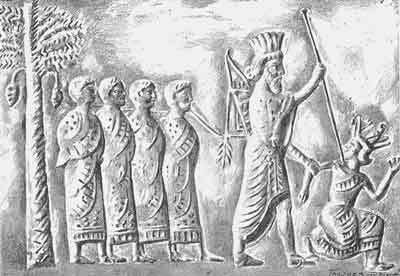
Darius Piercing a Rebel with his Lance before a Group of Prisoners (Image from St. Petersburg)
European and North African campaigns
About 512 BC Darius undertook a war against the Scythians. A great army crossed the Bosporus, subjugated eastern Thrace, and crossed the Danube. The purpose of this war can only have been to attack the nomadic tribes in the rear and thus to secure peace on the northern frontier of the empire. Yet the whole plan was based upon an incorrect geographical assumption; a common on in that era, and repeated by Alexander and his Macedonians, who believed that on the Hindu Kush (which they called the Caucasus Indicus) and on the shores of the Jaxartes (which they called Tanais, i.e. the River Don) they were quite near to the Black Sea. Of course the expedition undertaken on these grounds could only prove a failure; having advanced for some weeks into the Russian steppes, Darius was forced to return. The details given by Herodotus (according to him Darius had reached the Volga) are quite fantastic; and the account which Darius himself had given on a tablet, which was added to his great inscription in Behistun, is destroyed with the exception of a few words.
Although European Greece was intimately connected with the coasts of Asia Minor, and the opposing parties in the Greek towns were continually soliciting his intervention, Darius did not meddle with their affairs. The Persian wars were begun by the Greeks themselves. The support which Athens and Eretria gave to the rebellious Ionians and Carians made their punishment inevitable as soon as the rebellion had been put down. But the first expedition, that of Mardonius, failed on the cliffs of Mount Athos (492), and the army which was led into Attica by Datis in 490 was beaten at Marathon. Before Darius had finished his preparations for a third expedition an insurrection broke out in Egypt (486). In the next year Darius died, probably in October 485, after a reign of thirty-six years.
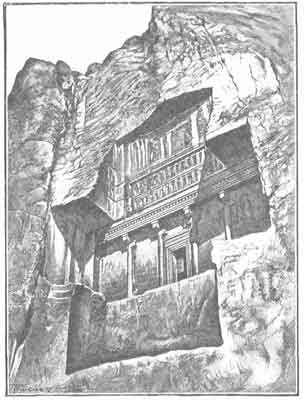
Tomb of Darius
.(Darius) therefore caused his tomb to be cut in the steep limestone cliff which borders the plain about half a mile to the north-west of the town. It is an opening in the form of a Greek cross, the upper part of which contains a bas-relief in which the king, standing in front of the altar, implores the help of Ahura-mazdâ poised with extended wings above him; the platform on which the king stands is supported by two rows of caryatides in low relief, whose features and dress are characteristic of Persian vassals, while other personages, in groups of three on either side, are shown in the attitude of prayer. Below, in the transverse arms of the cross, is carved a flat portico with four columns, in the centre of which is the entrance to the funeral vault. Within the latter, in receptacles hollowed out of the rock, Darius and eight of his family were successively laid. History of Egypt. G. Maspero
References
G. Maspero, History of Egypt, Chaldea, Syria, Babylonia and Assyria.
King of Persia , Pharaoh of Egypt Twenty-seventh Dynasty
Preceded by: Smerdis
Succeeded by: Xerxes I
|
Ancient Greece |
Medieval Greece / Byzantine Empire |
Modern Greece |
|---|---|---|
|
Science, Technology , Medicine , Warfare, , Biographies , Life , Cities/Places/Maps , Arts , Literature , Philosophy ,Olympics, Mythology , History , Images |
Science, Technology, Arts, , Warfare , Literature, Biographies, Icons, History |
Cities, Islands, Regions, Fauna/Flora ,Biographies , History , Warfare, Science/Technology, Literature, Music , Arts , Film/Actors , Sport , Fashion |

